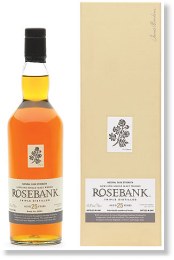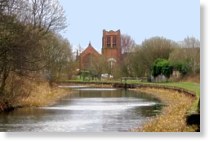| Rosebank
Single Malt Scotch Whisky
Site of the Former Rosebank Distillery
Falkirk, Stirlingshire, FK1 5BW Scotland
Viewer's Comments about Rosebank
 Alfred
Barnard visited the Rosebank Distillery a few years before
the publication of his book in 1887, The Whisky Distilleries
of the United Kingdom. Rosebank, he wrote, "is
one mile from Falkirk, and half a mile from the River Carron,
and is built on the banks of the Forth and Clyde Canal.
It is not isolated as many of the distilleries are, being
placed by the main road, on which there is a constant stream
of traffic, and also fronting the canal, where boats and
steamers are continually passing to and fro". Alfred
Barnard visited the Rosebank Distillery a few years before
the publication of his book in 1887, The Whisky Distilleries
of the United Kingdom. Rosebank, he wrote, "is
one mile from Falkirk, and half a mile from the River Carron,
and is built on the banks of the Forth and Clyde Canal.
It is not isolated as many of the distilleries are, being
placed by the main road, on which there is a constant stream
of traffic, and also fronting the canal, where boats and
steamers are continually passing to and fro".
The site, according to Barnard, "was chosen on account
of the inexhaustible supply of water"; but it had other
advantages. Its proximity to a coalfield must have reduced
the cost of transporting fuel, and the canal provided an
economic route for incoming barley and for consignments
of whisky to Glasgow, Leith, and other seaports.
Rosebank Distillery was recorded in 1817-19, when it was
managed by James Robertson. Its history on the present site
seems to have begun in 1840, when James Rankine, a former
grocer, acquired the maltings of Camelon Distillery, on
the east bank of the canal, and began operations as a distiller.
Five years later, according to Barnard, "the buildings
were considerably enlarged", and Rankine got into temporary
financial difficulties. They were "entirely rebuilt
in a modern day form" by his son, R.W. Rankine, in
1864. Offices, described by Barnard as handsome and newly-built
were later added. The red-brick buildings, facing the canal
and backing on to the road, were grouped around an interior
courtyard, and designed to make the best use of a restricted
space.
Rankine demolished the main buildings of the Camelon Distillery
in 1865, three years after it ceased trading, and replaced
them with a maltings. The two ranges of buildings were connected
by a swing-bridge and covered three acres (1.2 hectares).
They adjoined another two acres accommodating "the
grounds and gardens of Rosebank House, one of the residences
of Mr. Rankine", who lived mainly in Edinburgh.
Rankine achieved his object: to distil a whisky that would
stand comparison with the best Scottish makes. By Barnard's
day, output had reached 123,000 gallons (319,000 litres),
which was sold mainly to the Edinburgh and Glasgow markets.
In the 1890s, at the height of the distillery boom, there
was an extraordinary demand for Rosebank and many customers
had to be content with an allocation of a smaller amount
than they had ordered. The proprietor was the only malt
whisky distiller at the time who was able to charge his
customers warehouse rent.
The business was converted into a limited liability company,
under the name of Rosebank Distillery Ltd. in 1894. The
share capital was £120,000, of which 6,000 Ordinary
shares of £10 allotted to Rankine as vendor, and 6,000
Preference shares of £10 were taken up by others.
Three years later when James Rankine had become managing
director, the capital was increased to allow an issue to
the public of 4,000 Ordinary shares of £10 each at
a price of £20. Despite the premium, the issue had
an immediate success. Not long thereafter, the notorious
failure of Pettison Brothers, a Leith blending company,
created a redundancy of stocks on the whisky market; but
prudent management enabled Rosebank Distillery Ltd. to stay
the course until July 1914, when Scottish Malt Distillers
Ltd. (SMD) was formed to concentrate the resources of five
Lowland malt whisky distilleries, including Rosebank, at
a time of deepening recession in the industry.

The Forth & Clyde Canal |
All malt whisky distilleries were closed, by Government
order, from 1917 to 1919, in the interest of conserving
barley for foodstuffs. However, Rosebank was one of the
distilleries that remained in production throughout the
WWII.
Rosebank is widely regarded as the most distinguished of
the Lowland malts. Its House Style as described by Michael
Jackson is "Aromatic, with suggestions of clover and
camomile. Romantic. A whisky for lovers."
Rosebank was mothballed in 1993 and sold to British Waterways.
The site of this former distillery has since been developed
for residential use.
Courtesy of Diageo Scotland
|

